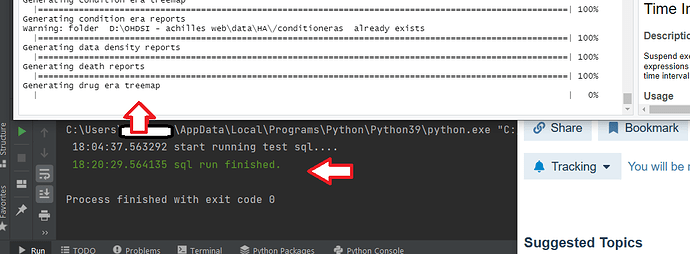Hi,
I’m setting up an OMOP CDM datasbase & tools for the first time in our organization.
The configuration is as follows:
- HW: 8 Xeon cores, 64GB RAM, 2GB SSD
- OS: Windows Server 2019
- DB: PostgreSQL 12
- CDM: version 5.1
- Data: IQVIA IMRD (~13M patients, largest table ~2.3G rows)
Following the detailed instructions, I’ve loaded the data, created constraints and indexes, and set up webAPI & Atlas. When running Achilles to create the data statistics I noticed that some of the queries take extremely long time to complete, so that running the entire SQL script generated by achilles may take few days (!).
My questions are:
-
What is the typical execution time of achilles initial run on a dataset of this size?
-
Are the sql queries generated by achilles optimized for a specific dialect? are the performance depend on the specific dbms?
-
for one query (11 Number of non-deceased persons by year of birth and by gender), a change in the syntax resulted in a large performance gain, which indicate that the query can be optimized for better performance:
The original (did not finish overnight):
SELECT
11 as analysis_id, CAST(year_of_birth AS VARCHAR(255)) as stratum_1,
CAST(gender_concept_id AS VARCHAR(255)) as stratum_2,
cast(null as varchar(255)) as stratum_3, cast(null as varchar(255)) as stratum_4, cast(null as varchar(255)) as stratum_5,
COUNT(distinct person_id) as count_value
FROM
imrd1903.person person
where person_id not in (select person_id from imrd1903.death)
the modified version (completed after 25 seconds):
SELECT
11 as analysis_id, CAST(year_of_birth AS VARCHAR(255)) as stratum_1,
CAST(gender_concept_id AS VARCHAR(255)) as stratum_2,
cast(null as varchar(255)) as stratum_3, cast(null as varchar(255)) as stratum_4, cast(null as varchar(255)) as stratum_5,
COUNT(distinct person_id) as count_value
FROM
imrd1903.person person
WHERE NOT EXISTS
(
SELECT NULL
FROM imrd1903.death death
WHERE person.person_id = death.person_id
)
Any other inputs and tips for improving the performance on the described system will be appreciated.
Thanks,
Guy.

 In your example, it sounds like PostgreS was used for transactional use cases which is what RDBMSs are built for. What PostgreS is not good at is large scale data analytics on large data sets where you have to scan through enormous amounts of data. It was simply not built to be a data warehouse. Everything has its purpose and optimized for that. I am sure PostgreS is great with typical transactional use cases.
In your example, it sounds like PostgreS was used for transactional use cases which is what RDBMSs are built for. What PostgreS is not good at is large scale data analytics on large data sets where you have to scan through enormous amounts of data. It was simply not built to be a data warehouse. Everything has its purpose and optimized for that. I am sure PostgreS is great with typical transactional use cases.